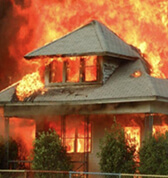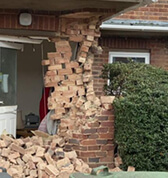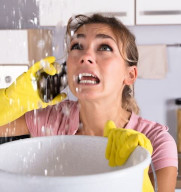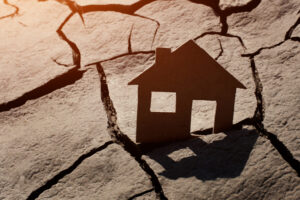Home » How to Identify Water Damage by Avner Gat, Inc.
How to Identify Water Damage
Water damage can be a disaster for any property owner. Drenched carpets, wet appliances, saturated bedding, and even mold are only some of the problems you might encounter after a water damage event.
Although water damage is often easy to locate, it is not always visible at first glance. The effects of moisture in flooring, drywalls, cabinets, etc. take time to manifest and can be costly to repair the longer it stays undetected.
In addition, there are different types of water damage. Some might require the intervention of a water damage restoration company to prevent further property damage and health hazards. Additionally, insurance companies do not treat all water damage events and consequences equally.
Avner Gat, Inc. has over 17 years of experience as a public adjuster in Southern California and we specialize in water damage claims.
We created this guide to help you identify water damage and what sets it apart from flood and mold damage.
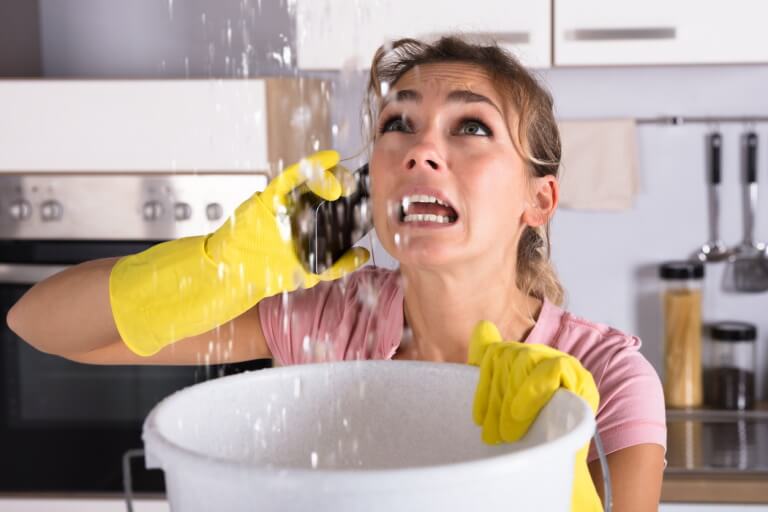
Water damage is the second most common cause of homeowners insurance claims after wind and hail damage. According to the Insurance Information Institute, about one in 60 insured homes has a property damage claim caused by water damage each year.
How Can You Tell If You Have Water Damage?
A water leak, leaking roof, burst pipe, flood, or fire hose can cause significant water damage to your home or belongings. Even if you try to prevent damage by cleaning up what you can right away, water or leftover moisture may seep into your surfaces, causing structural damage and promoting mold growth.
Water damage is often not apparent at first, and you can easily overlook it if you do not know what to look for and where.
Here are some typical red flags that might indicate an underlying problem:
- A significant increase in your water bill
- Wet patches on your ceiling, floors, or walls
- Hearing water drip
- A warm spot on the floor
- A loss of water pressure
- Bad smells or odors
- Stains or early signs of mold on your ceiling or walls
Here are common areas where potential water damage often occurs:
Ceilings
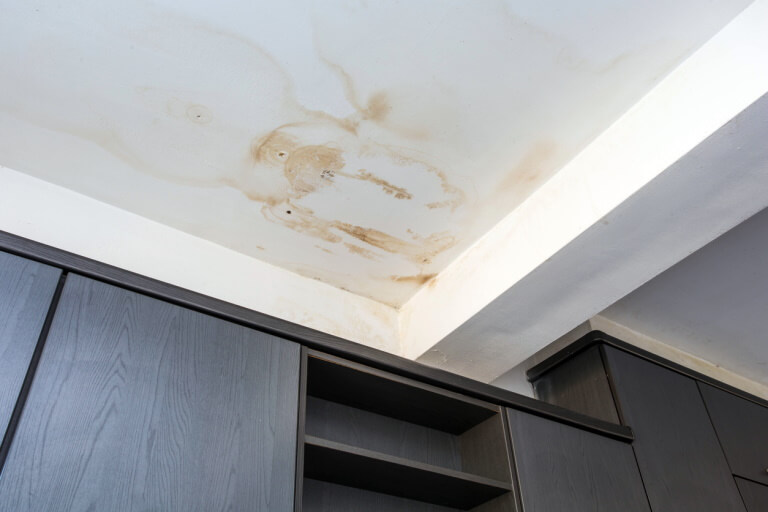
Pipes and HVAC drain lines in your ceiling can cause water damage over time from leaking pipes or condensation. In addition, damage to your roof caused by wind and hail or clogged drains can also cause water damage to your ceiling.
Signs of water damage on your ceiling might include:
- Sagging or discoloration of ceiling drywall or tiles
- Ceiling drywall or tiles which appear swollen
- Crumbling ceiling boards or panels
- Damp spot(s) or mold
Kitchens
Water damage often occurs in kitchens due to supply lines and the amount of plumbing in your typical kitchen. And appliances, such as washing machines and dishwashers, frequently develop leaks over time.
Signs of water damage in your kitchen might include:
- Moisture or mold and mildew behind appliances
- Raised or buckling of wood floors
- Bubbles or stains on vinyl or linoleum flooring
- Swelling of cabinets
Bathrooms
Bathrooms are typically high-humidity areas. And combined with poor ventilation, they often exhibit signs of water damage.
A leaking pipe in your wall is often the culprit. Drain line backups caused by clogged pipes can also push wastewater back through the line into your home. Backups commonly occur in toilets, showers, bathtubs, and basement drains.
Signs of water damage in your bathrooms might include:
- Mold and mildew on your ceiling and walls.
- Bubbling drywall and paint or stains.
- A foul-smelling musty odor
- Damp and swelling cabinets
- Spongy, loose, or peaking floor tiles
Is There a Difference Between Water and ”Flood” Damage?
Most people know what a flood is and what damage it might cause. And you are probably wondering why it is necessary to differentiate between water damage from a flood and other water damage or why you should even care.
Water damage is water damage regardless of what causes it, right? Wrong, at least in the eyes of your insurance company.
Many homeowners think their water damage insurance coverage includes damage caused by a flood. However, it is a popular misconception.
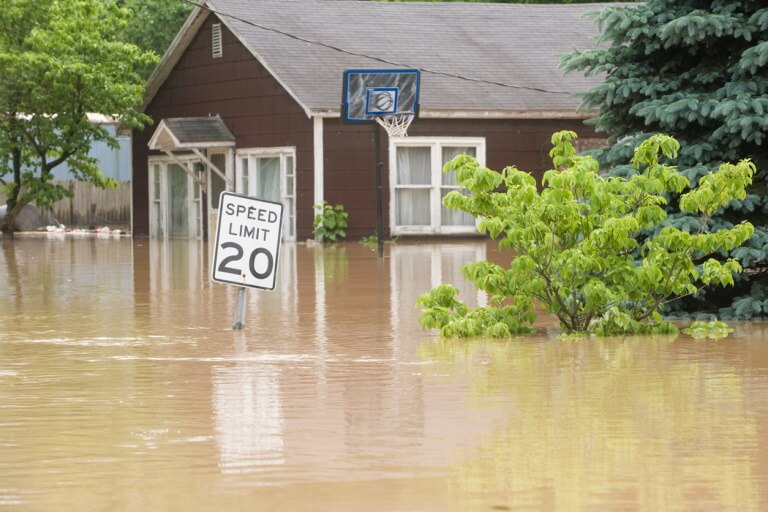
“California is prone to potentially devastating impacts of periodic floods. All 58 counties have experienced at least one significant flood event in the past 25 years, resulting in loss of life and billions of dollars in damages.” – Source: California Department of Water Resources
Standard homeowners’ insurance policies will not cover flood damage. If you want coverage, you should get a flood-specific insurance policy.
Based on the above, it is necessary to understand the difference between water and flood damage.
The key difference between water damage and flood damage is where the water originates.
Generally, if water falls from above or originates inside your home and flows out of it, it’s water damage. If water originates outside your home and flows into it, it’s flood damage.
Another way to look at it is to look at your next-door neighbors. If you and your neighbors suffer damage caused by rising waters, it’s flood damage. However, if you have a water issue inside your home and your neighbors don’t, it’s typically water damage.
A flood is, at least according to the Federal Emergency Management Agency (FEMA):
A general and temporary condition of partial or complete inundation of two or more acres of normally dry land area or two or more properties (at least one of which is the policyholder’s property) from:
– Overflow of inland or tidal waters;
– Unusual and rapid accumulation or runoff of surface waters from any source; or
– Mudflow; or
A collapse or subsidence of land along the shore of a lake, or a similar body of water, due to erosion or undermining caused by waves or currents of water exceeding anticipated cyclical levels that result in a flood.
Is There a Difference Between Water and ”Mold” Damage?
Mold often occurs after a water damage event, such as a burst pipe. However, it can also appear due to dampness and excess moisture in the air, leading to condensation. High humidity levels and poor ventilation can cause mold to spread fast.
Based on the above, although a burst or dripping pipe, flood, or leaking roof is often an ideal catalyst for mold growth, it is not required. For example, mold and mildew frequently thrive in high-humidity environments such as bathrooms.
There are over 100,000 indoor and outdoor types of mold. Under the right conditions, mold can germinate and start growing within 24 – 48 hours. Early detection and corrective action are the only ways to prevent mold growth.
The challenge is that mold growth is often hidden or not visible at first – it typically takes around three weeks before you can see it with the naked eye. By that time, mold spores might have spread to other areas of your home.
Mold needs moisture and a nutrient source to grow. Nutrient sources include wood, insulation, carpets, cardboard, ceiling tiles, wallpaper, drywall, fabric, and upholstery.
Both water and mold damage can cause structural damage. However, whereas water damage, such as damage caused by a fire hose, can cause immediate damage, mold damage usually takes longer to manifest.
Mold will eventually eat away at the surface of what it grows on, causing rot and weakening, destroying that surface.




















